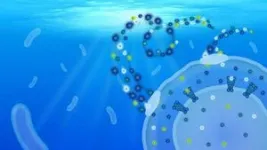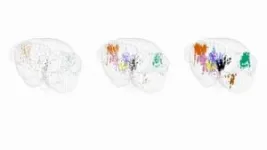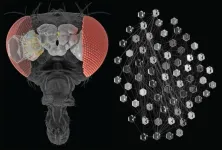(Press-News.org) If you were to collect all the organisms from the ocean surface down to 200 meters, you’d find that SAR11 bacteria, though invisible to the naked eye, would make up a fifth of the total biomass. These bacteria, also known as Pelagibacterales, have evolved to thrive in nutrient-poor marine environments and play a significant role in global nutrient cycles. Despite their importance, the mechanisms behind their impact on the planetary ecosystem have remained unclear.
But now, a recent Nature paper by researchers from the Okinawa Institute of Science and Technology (OIST) sheds light on a crucial aspect of these bacteria. “We knew that SAR11 is a key player in important nutrient cycles, such as carbon and sulfur exchanges, but we didn’t know the full extent,” explains Dr. Ben Clifton, first author of the paper, adding that “now, by comprehensively mapping out the transport proteins of the bacteria, we have a much better picture of how SAR11 slots into these cycles.” Professor Paola Laurino, the senior author, credits global seawater sampling projects like the Tara Oceans project for providing the metagenomic data that made this breakthrough possible: “these datasets have allowed us to link genomic data to protein function.”
Piecing together the protein puzzle
Transport proteins are vital for moving nutrients in and out of bacterial cells, shaping how bacteria interact with their environment. This is especially significant for SAR11 bacteria, whose nutrient uptake has a broad impact on global nutrient cycles. But despite their abundance in the oceans, these bacteria are difficult to study due to their specific growth requirements. To overcome this, the researchers genetically modified E. coli bacteria to express SAR11 transport proteins, allowing them to study the proteins in the lab.
Analyzing these genes across the SAR11 metagenome – the genetic material common to all SAR11 species – required global data, which was made possible by extensive genomic databases. The team identified genes linked to crucial marine processes, such as a protein that interacts with DMSP, a compound vital to the sulfur cycle and climate regulation. In total, they discovered thirteen transport proteins, including those for DMSP, amino acids, glucose, and taurine, all of which have significant environmental roles.
The logistics of global nutrient cycles
“Through these experiments, we discovered specific properties of transport proteins that enable SAR11 bacteria to thrive in nutrient-poor environments. This could not have been discovered from just looking at the genomic makeup alone,” summarizes Dr. Clifton. However, the team’s research on SAR11 is far from over. Having identified the proteins responsible for nutrient transport, they are now delving into the metabolic pathways to understand how these nutrients are utilized and converted within the bacteria. Additionally, in collaboration with the Weizmann Institute of Science, they are exploring how SAR11 interacts with its environment before absorbing nutrients.
This study is part of a growing trend that links environmental DNA to protein function, paving the way for new discoveries about how microscopic life forms influence global processes. As Prof. Laurino puts it, “by bridging the macro perspective of marine diversity and the micro perspective of protein biochemistry, we’re setting the stage for further questions about how bacterial proteins fit into global nutrient cycles, and how these bacteria contribute to, and are affected by, climate change and shifts in ocean biodiversity.”
END
How the oceans’ most abundant bacteria impact global nutrient flows
A new Nature paper has revealed how key bacterial proteins contribute to global carbon, sulfur and other nutrient cycles.
2024-09-11
ELSE PRESS RELEASES FROM THIS DATE:
Discovery of a new phase of matter in 2D which defies normal statistical mechanics
2024-09-11
Physicists from the Cavendish Laboratory in Cambridge have created the first two-dimensional version of the Bose glass, a novel phase of matter that challenges statistical mechanics. The details of the study have been published in Nature.
As the name suggests, the Bose glass has some glassy properties and within it all particles are localised. This means that each particle in the system sticks to itself, not mixing with its neighbours. If coffee was localised, then when stirring milk into the coffee, the intricate pattern of black and white stripes would remain forever, instead of washing out to an average.
To create this new phase of matter, the group overlapped several laser ...
Genes with strong impact on menopause timing also link to cancer risk
2024-09-11
New research has found four genes with some of the largest known effects on the timing of menopause discovered to date, providing new insight into links between menopause timing and cancer risk.
Genes come in pairs, and when women only have one working copy of the four new genes identified (ETAA1, ZNF518A, PNPLA8, PALB2), they have menopause between two and five-and-a-half years earlier than average.
Published in Nature, the large-scale analysis was funded by the Medical Research Council and Wellcome. The team first looked at variation in data from genetic sequencing of 106,973 post-menopausal ...
Ancient DNA from Rapa Nui (Easter Island) refutes best-selling population collapse theory
2024-09-11
Rapa Nui or Te Pito o Te Henua (the navel of the world), also known as Easter Island, is one of the most isolated inhabited places in the world. Located in the Pacific, it lies over 1,900 km east of the closest inhabited Polynesian island and 3,700 km west of South America. Although the island, its inhabitants and their rich culture have been extensively studied by archaeologists, anthropologists and geneticists, two key elements of Rapanui history remain very controversial to this day. One of these is the theory of population collapse through "ecocide" or "ecological ...
Researchers combine the power of AI and the connectome to predict brain cell activity
2024-09-11
With maps of the connections between neurons and artificial intelligence methods, researchers can now do what they never thought possible: predict the activity of individual neurons without making a single measurement in a living brain.
For decades, neuroscientists have spent countless hours in the lab painstakingly measuring the activity of neurons in living animals to tease out how the brain enables behavior. These experiments have yielded groundbreaking insights into how the brain works, but they have only scratched the surface, leaving much of the brain unexplored.
Now, researchers are using artificial intelligence and the connectome – a ...
New research shows clinical trials inappropriately excluding people of African/Middle Eastern descent
2024-09-11
BOSTON – Many clinical trials of new cancer drugs may be inappropriately excluding some people with "Duffy-null phenotype," a trait found predominantly in people of African or Middle Eastern descent, researchers at Dana-Farber Cancer Institute and Queen Mary University of London report in a new study.
The Duffy-null phenotype results in relatively lower levels of white blood cells called neutrophils when measured in the blood. This is not because they have less neutrophils overall, but because they are more frequently located in other body tissues. Tests that restrict clinical trial eligibility to patients with certain blood levels of neutrophils may therefore ...
Examining the hypertension control cascade in adults with uncontrolled hypertension in the US
2024-09-11
About The Study: In this cross-sectional study, more than 50% of adults with uncontrolled hypertension in the U.S. were unaware of their hypertension and were untreated, and 70.8% of those who were treated had hypertension that remained uncontrolled. These findings have serious implications for the nation’s overall health given the association of hypertension with increased risk for cardiovascular disease.
Corresponding Author: To contact the corresponding author, LaTonia C. Richardson, PhD, email lcrichardson@cdc.gov.
To access the embargoed study: ...
Neighborhood child opportunity and preterm birth rates by race and ethnicity
2024-09-11
About The Study: In this cross-sectional study of neighborhood opportunity and preterm birth, elevated risk associated with exposure to a very low opportunity neighborhood, coupled with the disproportionate exposure by race and ethnicity, points to a modifiable factor that may contribute to racial and ethnic inequities in preterm birth. Future research should investigate interventions that seek to address neighborhood opportunity.
Corresponding Author: To contact the corresponding author, Candice Belanoff, ScD, MPH, email cbelanof@bu.edu.
To ...
Researchers uncover shared cellular mechanisms across three major dementias
2024-09-11
Researchers have for the first time identified degeneration-associated “molecular markers” – observable changes in cells and their gene-regulating networks – that are shared by several forms of dementia that affect different regions of the brain. Critically, the UCLA-led research, published in the journal Cell, also identified markers specific to different forms of dementia, and the combined findings represent a potential paradigm shift in the search for causes, treatments and cures.
“This ...
The Neanderthals may have become extinct because of their isolated lifestyle
2024-09-11
Neanderthal remains recently discovered in a cave in France support well-known theory of why the Neanderthals became extinct, researchers behind a new study say.
In recent years, researchers have offered different explanations for why modern humans survived and the Neanderthals became extinct some 40,000 years ago.
A new study from the Globe Institute at the University of Copenhagen supports one of the main hypotheses. The researchers behind the new study discovered Neanderthal remains of a male in a cave in southern France, ...
Microorganisms can travel long distances in the troposphere
2024-09-11
Analysis of air samples taken at altitudes of up to 3,000 metres above Japan has revealed the presence of a vast range of viable bacteria and fungi transported by air masses originating more than 2,000 kilometres away, in regions enriched with fertilisers and pesticides. The study, published in Proceedings of the National Academy of Sciences (PNAS), reveals a new way in which human, animal and plant pathogens may travel to distant geographical regions. This research has been led by the Barcelona Institute for Global Health (ISGlobal), a centre supported by “la Caixa” Foundation, in collaboration with the Daniel ...
LAST 30 PRESS RELEASES:
Making lighter work of calculating fluid and heat flow
Normalizing blood sugar can halve heart attack risk
Lowering blood sugar cuts heart attack risk in people with prediabetes
Study links genetic variants to risk of blinding eye disease in premature infants
Non-opioid ‘pain sponge’ therapy halts cartilage degeneration and relieves chronic pain
AI can pick up cultural values by mimicking how kids learn
China’s ecological redlines offer fast track to 30 x 30 global conservation goal
Invisible indoor threats: emerging household contaminants and their growing risks to human health
Adding antibody treatment to chemo boosts outcomes for children with rare cancer
Germline pathogenic variants among women without a history of breast cancer
Tanning beds triple melanoma risk, potentially causing broad DNA damage
Unique bond identified as key to viral infection speed
Indoor tanning makes youthful skin much older on a genetic level
Mouse model sheds new light on the causes and potential solutions to human GI problems linked to muscular dystrophy
The Journal of Nuclear Medicine ahead-of-print tip sheet: December 12, 2025
Smarter tools for peering into the microscopic world
Applications open for funding to conduct research in the Kinsey Institute archives
Global measure underestimates the severity of food insecurity
Child survivors of critical illness are missing out on timely follow up care
Risk-based vs annual breast cancer screening / the WISDOM randomized clinical trial
University of Toronto launches Electric Vehicle Innovation Ontario to accelerate advanced EV technologies and build Canada’s innovation advantage
Early relapse predicts poor outcomes in aggressive blood cancer
American College of Lifestyle Medicine applauds two CMS models aligned with lifestyle medicine practice and reimbursement
Clinical trial finds cannabis use not a barrier to quitting nicotine vaping
Supplemental nutrition assistance program policies and food insecurity
Switching immune cells to “night mode” could limit damage after a heart attack, study suggests
URI-based Global RIghts Project report spotlights continued troubling trends in worldwide inhumane treatment
Neutrophils are less aggressive at night, explaining why nighttime heart attacks cause less damage than daytime events
Menopausal hormone therapy may not pose breast cancer risk for women with BRCA mutations
Mobile health tool may improve quality of life for adolescent and young adult breast cancer survivors
[Press-News.org] How the oceans’ most abundant bacteria impact global nutrient flowsA new Nature paper has revealed how key bacterial proteins contribute to global carbon, sulfur and other nutrient cycles.





